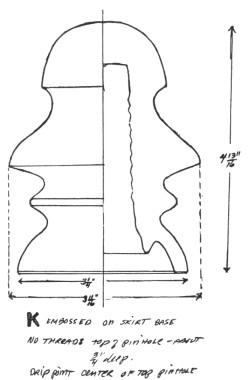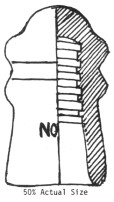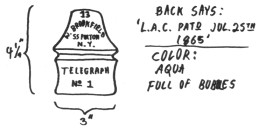Questions Answered by N. R. Woodward
Author of The Glass Insulator in America and originator of C.D. #'s (Consolidated Design Numbers)
Reprinted from "INSULATORS - Crown Jewels of the Wire", February 1976, page 8
Glenn Polasik, Green Bay, Wisconsin, writes: At a flea market I picked up a
CD 166.2 that I cannot find in the book. I hope you can help me. The color is
ice blue. It has a large glass button under the dome, smooth base, and on the
front of the skirt is a good size glass button, and on the back of the skirt is
another same size glass button. Do you have any idea as to its rarity? Thank
you.
- - - - - - - - -
In reply to Glenn Polasik: Unfortunately there is little comment that can be
made concerning the CD 166.2. It is an unidentified and unembossed style,
probably made by the same works that made several other unmarked insulators that
bear a strong resemblance. The one that I have seen did not have the glass
buttons on each half-mold; but they are a fairly common feature of a number of
the early molds. As to its rarity, insofar as I know, very few of this number
have been located, so it would be a scarce item with or without the buttons.
From Robert L. Hutchison, Napoleon, Ohio: I'm a lineman for a telephone
company in northwestern Ohio. The other day while taking down an old line I came
across an unusual C.D. 102 Star. It is very much like many others I have, except
that there is a very small star on side opposite of the side where there is a
star regular in size. I have never seen any others. Please let me know if you
have. And could you tell me the rarity of this insulator. Color light aqua.
Thank you very much.
- - - - - - - - -
In reply to Robert L. Hutchison: The CD 102 Star pony with the very tiny star
on one half-mold is not extremely rare. It's a desirable and interesting
variation; and anyone's guess as to the reason for the tiny star.
Doug Polak, Fort Wayne, Indiana, states: I have a question about a
"Star" insulator I have found. It is a CD 162.3 deep groove double
petticoat. Everything is normal, except there is no inner skirt! Is this a
common error, or a rarity? Please advise me! Thank you.
- - - - - - - - -
In reply to Doug Polak: The insulator which you are listing as a CD 162.3 is
probably a CD 134. Although the diameter of the Hemingray No. 18 which was used
for the CD 134 drawing in the "Reports" is 2-7/8 inches, there is
considerable variation in that number, and the Star CD 134 is probably 3 inches
or so across the base. Also the CD 134 has a fuller, deeper groove than the CD
162.3. If this explanation doesn't fit what you have, contact us again with a
more thorough description. It's always possible that you do have something
different!

From Lew Hohn, Rochester, N.Y.: Picked up the enclosed insulator (drawing)
recently. As you can see, it is quite a bit different from regular CD 202.
Would like to find out more about it? Any ideas as to maker. Lack of threads and
the drip point in top of pinhole sort of suggest American Ins. Would
appreciate any info. you or others may have. Being primarily a porcelain
collector, I am not completely familiar with out of ordinary glass insulators.
- - - - - - - - -
In reply to Lew Hohn: The CD 202 "K" has been known for some time,
but no real evidence of its source has been found. That style was, of course,
made basically under the May 22, 1894 Fred Locke patent; and perhaps the makers
of the "K" did not have rights to use that patent and were not anxious
to identify their insulator fully!
Jim Crutchfield, North Augusta, South Carolina, writes: I have recently
acquired a Hawley insulator (CD 102) with two "dimples". They are
located on the side of the insulator just above the base. What explanation can
you give for this? Could this be the result of a faulty mold? Perhaps this is
also the reason for the inconsistency in the size of the letters that are
embossed on this insulator.
- - - - - - - - -
In reply to Jim Crutchfield: The "dimples" in the glass are called
"folds". They are the result of partial cooling of the surface of the
glass during the slight time required for the molten glass blob to settle into
the mold. Thus the surface of the glass at that point does not quite fuse
properly, or does not quite fill out against the mold as it should. Folds are
common in old insulators; but modern insulator presses are timed so precisely,
and the glass is delivered to them under carefully controlled temperature, so
that folds are rare in newer insulators.
From Richard C. Wiesman, Sterling Junction, Massachusetts: I have a couple of
insulators I just acquired and can't find them in Milholland's book and was
wondering if they are anything special. Here is a description of both: CD 155
Armstrong DP 1, light lime green (A-encircled) SB; CD 121 No Name looks like AM TEL & TEL
CO. blocked out, has a double one or 11 on top with glass between, making it
look like a solid piece of raised glass. The Armstrong is the most unusual
because it mentions Armstrong using light green and flint up to 1946, and after
just flint and amber (from Milholland's). The one I mention is dated 1950 (50
with no date after). If you can help me I would appreciate it. Thank you.
- - - - - - - - -
In reply to Richard Wiesman: Although it is true that most of the Armstrong
insulators (other than the dark ambers) are of pale tints or nearly clear, there
was a time in 1950 when some DP 1 were made in colors. There is the light green
of which you speak, also a greenish amber which is fairly dark in some cases.
These colors seem to have occurred only during that one year, and only in the
one style. Rather than a deliberate choice, this almost certainly resulted from
a variation in glass formula, perhaps a shortage of decolorizer. They were sold
to Western Electric and put in service on Bell System lines along with the
others; and probably everyone but collectors has forgotten about the episode.
I have seen the CD 121 that was made in an old Am Tel. & Tel. Co. mold.
It looks very much like Brookfield glass; but probably the answer to this one
will never be known. You can also find the AM. TEL. & TEL. Co. made in that
same mold set with the shop number 11 on the crown.
Jim Woods, Collinsville, Illinois, writes: I have a few insulator finds I
would like to get some information on. I have a CD 191 A.T. & T. Co. in
small letters that has a mold line over the top. It's a definite mold line and
not a mold flaw. I don't find anything on these listed in any books and wonder
if many exist.
I recently purchased a CD 164 H.G. Co. dated. However, instead of PETTICOAT
on the back, it says PETTICOAY--a definite Y. Have any of these been reported?
I have a CD 162 with a 3/8" vertical bar on each side. Underneath the
bar on one side and very light appears KCGW. This is apparently the same
insulator as on Line 1824 in Milholland's 1975 Price Guide. I have seen a second
insulator with a little stronger lettering.
Last, an insulator I traded for some time ago. It's a CD 152 "B" in
deep green amber blackglass. The primary color is amber. Have any of these been
reported?
- - - - - - - - -
In reply to Jim Woods: The H. G. CO. CD 164 with PETTICOAY error is listed in
the book Insulators with Embossing Errors by Frances Terrill and Warren Olson.
It's on page 49.
Unfortunately, no one knows who made the K.C.G.W. insulators or who used the
molds later to make these that you describe. Quite a few of both have been
located; but they are fairly old, and far from common. They go very well in a
collection! Some day perhaps we will have the complete story on these.
During the early 1900's the Brookfield's Old Bridge plant used a great deal
of cullet, or scrap glass, primarily bottles. As amber glass mixed with the
green, the streaks and swirls of amber were created; and from time to time there
are insulators that are almost pure amber. This occurs in all styles that were
made in large quantity during that period. Detail of coloring changed frequently
during production and was of no concern to them at that time. Not many years
later, however, the major buyers became very much more particular and eventually
insisted on clear, or nearly clear, glass. Incidentally, I was looking at a CD
152 "B" in amber, exactly as you describe, only last Saturday on an
old Western Union wire in a small community in central Texas!
Without seeing the A.T.& T. CD 191, it's difficult to guess just what you
have. It's true that not many are found with the two-piece mold characteristics.
From Fran E. Beauchamp, Hurley, Wisconsin: On a recent outing collecting
insulators I came across an H.G. CO. that was embossed with petticoat on the
back of the skirt. It was in the usual aqua, but upon better inspection it has a
B on top of it instead of the usual H. Up until now I thought that all H.G. Co.
were made by Hemingray, but now I am wondering.
To make this insulator even more different, was a double lined backward S
above the wire groove half way between the front and back. Maybe you could give
me more information on this type of insulator.
- - - - - - - - -
In reply to Fran Beauchamp: The H. G. CO. that you have is Hemingray. The B
is the mold letter, rather than an indication of the maker (as it is when
appearing on Brookfield insulators). That mold set has letters from A to N. The
letters aren't always in the same place; and sometimes the letter appears in two
places on the insulators. Yours should have another B (possibly faint) below
PETTICOAT on the skirt. That is the first mold set for that style by Hemingray.
The double backward S would be a coincidence, just a slight fold in the glass
that took that shape.

Matt Leissring, Santa Rosa, California, writes: I have an interesting piece
of glass here. It says NO. 9, but nothing else. It is similar to a CD 106, but
the groove is not in line with the base. It has a few bubbles. It was found on a
side pin on a tree near Santa Cruz. Being a pale aqua, I think it was made by
Hemingray at Covington, Kentucky. The glass is too smooth to have been made in
Muncie, Indiana. What do you think?
- - - - - - - - -
In reply to Matt Leissring: Your No. 9 CD 106 is not familiar to me;
therefore I can't give an answer. From your description, I would not think it is
a Hemingray, but it may be. There are a couple of other good possibilities but none of them could
be verified without examining it. Meanwhile, I can only say that you do have
"an interesting piece of glass", as you stated!

From Clifford W. Kennedy, Penryn, California: At left is a drawing of an
insulator I found along the R.R. tracks. Could you tell me anything about it?
- - - - - - - - -
In reply to Clifford W. Kennedy: Your CD 131 is most interesting! As you
probably know, the 55 FULTON ST. address dates it during the period 1868 to
1882. However, when only the July 25, 1865 date appears, it can be assumed that
the insulator was probably made during the earlier part of the period. That
patent, covering the internal thread feature, was re-issued February 22, 1870;
and the tendency is to find that later date on the later insulators. However,
this is not a positive dating, but only a general consideration. The L.A.C. is,
of course, Louis A. Cauvet, to whom the patent was issued.
Up to this point, the insulator is quite a desirable item, but not really
rare. Now, however, comes the skirt lettering TELEGRAPH No. 1. That is
altogether a different matter, and nothing can be added except to say that,
since you said you found it along "the R.R. tracks", better go back
and look for more!
| 